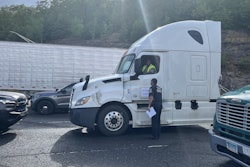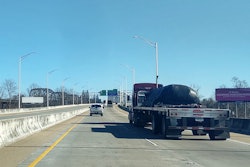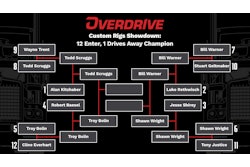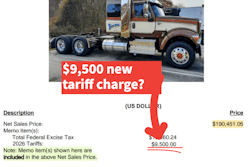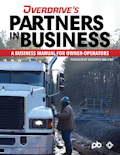The White House has released its Spring 2025 Unified Agenda of Regulatory and Deregulatory Actions, offering a glimpse of the priorities of departments across the federal government, including the Department of Transportation.
There are more than 40 trucking-related regulations -- most of which come from of the Federal Motor Carrier Safety Administration -- listed in the Unified Agenda, and reporting Thursday, September 4, highlighted some of the more hot-button regs: side underride guards, broker transparency, automatic emergency braking, independent contractor classification and others.
Below, find a rundown of the dozens of other rulemakings related to trucking included in the agenda, sorted by how far along in the rulemaking process they are. Many rulemakings in the “final rule” stage were part of FMCSA’s 18 proposals earlier this year to rescind and amend regulations that the DOT called “burdensome regulations that do not enhance safety.”
With each listed rulemaking is DOT's estimate of when the next stage is expected. It's been common for many years, however, for agencies to miss those estimated timelines by months or even years, including broker transparency, which missed several deadlines before a notice of proposed rulemaking was published in November 2024.
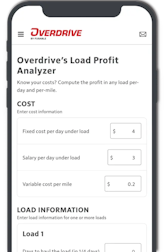
[Related: The 18 'burdensome' regulations FMCSA proposes to rescind, amend]
Pre-rule stage
- New entrant safety assurance process: This rulemaking would consider methods for ensuring a new applicant carrier is knowledgeable about the applicable safety requirements before being granted New Entrant authority. FMCSA is considering whether to implement a proficiency examination as part of its revised New Entrant Safety Assurance Process, as well as other alternatives. The last action taken on this rule was in 2009, when an advance notice of proposed rulemaking (ANPRM) was issued. FMCSA is now projecting May 2026 for a second ANPRM to be published.
- Minimum training standards for entry-level truck drivers, addressing sexual harassment of women truckers and trainees: FMCSA is planning an ANPRM to publish by May 2026 that would seek information from stakeholders on ways the agency might enhance the physical safety of female truck drivers and trainees and address the negative impacts of workplace sexual harassment. In addition, the ANPRM would seek information regarding ways in which FMCSA can enhance the safety of vulnerable road users, such as pedestrians and bicyclists.
[Related: Six core challenges deterring women from entering trucking]
Proposed rule stage
- Repeal of greenhouse gas rules and Endangerment Finding: Outside the Department of Transportation, the Environmental Protection Agency is planning this month to finalize its repeal the Greenhouse Gas Phase 3 rule, which EPA said "provided the foundation for the Biden-Harris electric vehicle mandate," along with GHG rules for light- and medium-duty vehicles. The final rule would also repeal the 2009 Endangerment Finding and regulations and actions that rely on it. EPA announced the proposed repeals in July.
- MAP-21 enhancements and other updates to the Unified Registration System: FMCSA is projecting to publish a notice of proposed rulemaking (NPRM) by March 2026 that would implement several provisions of the Moving Ahead for Progress in the 21st Century Act (MAP-21) that relate to the agency’s Unified Registration System (URS), as well as update and codify the agency's procedures for granting, suspending, and revoking registration. Many of the proposed provisions codify existing practices, FMCSA said, while others improve on existing processes and procedures. The rule would “achieve greater transparency, uniformity, efficiency, and predictability with respect to granting, suspending, or revoking registration.”
- Preservation of records: This NPRM would propose changes to the record retention requirements contained in 49 CFR Part 379, Appendix A to remove overlapping and burdensome requirements. It’s expected by the end of May 2026.
- Motor carrier operation of automated driving system (ADS)-equipped CMVs: Following a second ANPRM in 2023 seeking feedback about factors the agency should consider in amending federal regulations to establish a regulatory framework for autonomous trucks, FMCSA is planning an NPRM by May 2026 to amend certain regs to ensure the safe introduction of automated driving systems (ADS)-equipped trucks and other commercial vehicles on the nation's roadways. The proposed changes will relate to equipment operations, inspection, repair and maintenance regulations, and will prioritize safety and security, promote innovation, foster a consistent regulatory approach, and recognize the difference between human operators and ADS.
- Drug and Alcohol Clearinghouse revisions: FMCSA plans to propose changes to its drug and alcohol use and testing rules by May 2026 by increasing the availability of driver violation information in the Drug and Alcohol Clearinghouse.
- Electronic logging device (ELD) rule revisions: Since the implementation of the ELD mandate, FMCSA said many lessons have been learned by its staff, state enforcement personnel, ELD vendors and the industry, which can be used to streamline and improve the clarity of regulatory text and ELD specifications. The agency plans an NPRM by May 2026.
- Cargo securement: An NPRM expected by May 2026 would ensure consistency between the FMCSA requirements in 49 CFR part 393 and the Canadian Council of Motor Transport Administrators (CCMTA) National Safety Code (NSC) 10 cargo securement requirements.
- Household goods motor carrier registration: FMCSA plans to publish an NPRM by May 2026 that would allow a person to register as an HHG motor carrier only after that person "demonstrates, before being registered, through successful completion of a proficiency examination established by the Secretary [of Transportation], knowledge and intent to comply with applicable Federal laws relating to consumer protection, estimating, consumers' rights and responsibilities, and options for limitations of liability for loss and damage."
- Driver medical qualifications, seizure standard: FMCSA will propose by May 2026 to amend 49 CFR 391.41(b)(8) to update the physical qualification standards for individuals with an established medical history or clinical diagnosis of epilepsy or any other condition which is likely to cause loss of consciousness or any loss of ability to control a CMV. The proposal would reduce the burden on individuals who have experienced a seizure, or who have been prescribed antiseizure medication, provided certain criteria are satisfied. The criteria would mirror those used for the agency's Seizure Exemption Program, including a requirement for the drivers to obtain documentation from the treating neurologist that the individual has been seizure-free for a period of several years.
- Administrative removal of medical examiners from National Registry: An NPRM planned early next year would amend 49 CFR 390.115 to provide an administrative removal process for medical examiners who are not in compliance with certain administrative requirements for continued listing on the National Registry of Certified Medical Examiners.
- UCR Plan fees for 2026: This NPRM would be the annual adjustment of registration fees for the Unified Carrier Registration (UCR) Agreement, expected by May of next year.
- Incorporation by reference of new State Procedures Manual (SPM) for CDLIS: This rule, expected next year, would incorporate by reference the expected updates to manuals published by the American Association of Motor Vehicle Administrators (AAMVA). FMCSA would amend its rules to update the current incorporation by reference.
- Incorporation by reference of CVSA’s updated out-of-service criteria: This proposal would incorporate by reference the 2025 update to the out-of-service criteria for commercial motor vehicles, published by the Commercial Vehicle Safety Alliance. The NPRM is expected this month.
- Clarification of the applicability of emergency declarations: By the end of this year, FMCSA plans to propose changing the time limit for automatic emergency relief for regional declarations of emergency, reverting back to the 30-day limit which existed prior to the issuance of the October 2023 final rule.
- Fees for the use of the Commercial Driver's License Information System (CDLIS): This rulemaking, expected by May 2026, would implement the provisions of the “Strengthening the Commercial Driver’s License Information System Act,” passed in December 2024, modifying the fee system requirements to specify that the DOT or an authorized operator can collect user fees for the CDLIS and use those fees to operate, maintain, develop, modernize and enhance the CDLIS. The proposal would implement a user-fee based approach, allowing the CDLIS to operate as a self-sufficient system.
[Related: Rise of the 'non-domiciled CDL' for non-citizen truck drivers: Safety, rates, security]
Final rule stage
- Hazmat and passenger commercial vehicles and railroad crossings: By the end of this year, FMCSA plans to publish a final rule to amend the FMCSRs related to driving a CMV at a highway-rail grade crossing. The agency accepted comments on a proposal earlier this year to eliminate the mandatory stop at grade crossings currently required for drivers of certain CMVs and prohibit drivers of all CMVs from driving onto a grade crossing without exercising due caution (including slowing down, as necessary) upon approaching the crossing to ascertain safe clearance. This rule would also make conforming amendments elsewhere in the Code of Federal Regulations (CFR).
- Retroreflective sheeting on trailers: FMCSA plans to publish a final rule by the end of 2025 to rescind the requirements for retroreflective sheeting on semitrailers and trailers manufactured prior to Dec. 1, 1993, which is the compliance date for NHTSA’s conspicuity rules applicable to trailer manufacturers. The agency said it believes “the vast majority of trailers currently in use on the Nation’s highways were manufactured after 1993 so the retrofitting rule is no longer necessary.”
- Spare fuses: This final rule, expected this year, would remove the requirement for commercial motor vehicles (CMVs) to be equipped with at least one spare fuse for each type and size of fuse needed for the parts and accessories of the CMV.
- Liquid-burning flares: FMCSA plans to publish this year a final rule to remove references to liquid-burning flares from the warning device requirements in the FMCSRs. The agency said the revision would remove outdated language referring to warning devices that FMCSA believes are no longer used.
- Self-reporting requirement: This final rule, expected this year, would revise FMCSA’s regulations requiring CDL holders to self-report motor vehicle violations to their state of domicile. With the implementation of the exclusive electronic exchange of violations between state drivers licensing agencies (SDLAs) in 2024, self-reporting is no longer necessary.
- Removal of obsolete references to “water carriers”: In another final rule expected this year, this one would remove all obsolete references to “water carriers” in the FMCSA regulations. FMCSA said it does not specifically regulate water carriers except to the extent that such carriers also engage in motor carrier operations. In such cases, the existing FMCSRs provide appropriate coverage of the carrier’s operations. The term is used in several sections of the FMCSRs and was carried over from FMCSA’s predecessor agencies.
- Vision standards grandfathering provision: FMCSA plans to amend its regulations this year to remove the grandfathering provision under the physical qualifications standards for interstate drivers operating under the previously administered vision waiver study program -- the provision is now obsolete, the agency said. The waiver study program was terminated prior to the adoption of rules in 1998 implementing the Transportation Equity Act for the 21st Century highway bill's provision concerning waivers, exemptions and pilot programs. A 2022 rule that amended vision regulations eliminated the need for both the vision exemption program that then existed and the grandfather provision for drivers operating under the old wavier program. The grandfathering provision remained in effect until March 22, 2023, and after that, all drivers were required meet the new alternative vision standard.
- Requirement for ELD operator’s manual located in CMV: FMCSA also plans this year to rescind the in-vehicle ELD operator’s manual requirement. FMCSA currently maintains a list of the ELD vendors who have self-certified their products, including submission of the operator’s manual. Additionally, drivers are required to understand the operation of the ELD on the vehicle. FMCSA said there is no readily apparent benefit to continuing to require that the user's manual be in the truck.
- Electronic Driver Vehicle Inspection Reports (DVIRs): Expected this year, this final rule would clarify the requirement to complete a DVIR, based upon a public comment filed by the National Tank Truck Carriers (NTTC). The DVIR may already be completed electronically, however this proposal would add explicit language to make this clear. FMCSA believes this will encourage motor carriers and drivers to utilize electronic, cost-saving methods when completing DVIRs.
- Driver Vehicle Examination Report disposition update: FMCSA also plans to revise the requirement that motor carriers and intermodal equipment providers sign and return a completed roadside inspection form to the issuing state agency. FMCSA said it’s aware that not all issuing state agencies require the return of these reports. And requiring these reports to be sent to a state that does not require, or even request, the return of the form creates an unnecessary burden. Through this change, expected by the end of the year, completed forms need only be returned to those states that request them. The action is in response to a petition for rulemaking from CVSA.
- Fuel tank overfill restriction: In response to another CVSA request, FMCSA this year plans to finalize a rule that would remove the requirement in the motor carrier regs that a liquid fuel tank manufactured on or after Jan. 1, 1973, be designed and constructed so that it cannot be filled, in a normal filling operation, with a quantity of fuel that exceeds 95% of the tank’s liquid capacity. CVSA noted that liquid fuel tanks are now manufactured with a vented cap, which allow 100% fill, based on the positioning of the filler neck and vented cap, with no resulting issues.
- CDL standards; Requirements and penalties -- Applicability to the exception for certain military personnel: This revision to the regulations would allow dual-status military technicians to qualify for the exception for certain military personnel from the commercial driver license (CDL) standards in part 383 of the FMCSRs. The regulations currently do not allow U.S. Reserve technicians to qualify for the exemption. This rule responds to a petition for rulemaking submitted by James D. Welch, who said the current regulation places an unfair burden on career U.S. Air Force Reserve Technicians, who are required to wear the military uniform in the same manner as National Guard Military Technicians but are not similarly authorized to utilize the CDL exemption. The final rule is expected this year.
- Brakes on portable conveyors: This final rule expected this year would add an exception for portable conveyors used in aggregate industry operations and manufactured before 2010 from the requirements that each CMV be equipped with brakes acting on all wheels, provided certain conditions are satisfied. The change would provide relief from a regulatory requirement for certain portable conveyors without impacting safety.
- Accident reporting -- Modification to the definition of the term “Medical Treatment": FMCSA will publish this year a rule to amend its regulations to revise the term “medical treatment” for the purpose of accident reporting to incorporate revised regulatory guidance issued by the agency regarding medical treatment away from the accident scene. In 2022, FMCSA revised guidance to clarify that medical treatment did not include diagnostic procedures, such as x-ray or CT.
- License plate lamps: FMCSA this year will finalize a rule to provide an exception from the lamp and reflective device requirements for license plate lamps on the rear of truck tractors while towing a trailer. The agency said trucks pulling a trailer do not have a visible license plate on the tractor itself, as the plate would be blocked by the trailer
- Tire load markings: This final rule would revise the requirements for tires on commercial vehicles to clarify that regulations do not require tire load restriction markings on their sidewalls. This change would eliminate confusion and clarify the scope of FMCSA’s authority regarding the requirements for tires in the FMCSRs, the agency said. FMCSA added that regulated entities have mistakenly believed that § 393.75(g) and (h) require sidewall markings, and that markings missing from the sidewall would be a violation of those requirements. These provisions actually require that motor vehicles and manufactured homes are not operated with a weight in excess of the load limits on the sidewalls of the tires, or, for manufactured homes built before January 1, 2002, with a weight more than 18% over the load limits. A new paragraph would clarify that FMCSA does not require tire markings and avoid any further confusion about the scope and requirements of paragraphs (g) and (h).
- Hours of service -- Transportation of agricultural commodities: By May 2026, FMCSA plans to issue a final rule that clarifies the definition of the terms "any agricultural commodity," "livestock," and "non-processed food," as the terms are used in the definition of "agricultural commodity" for the purposes of hours-of-service regulations. This final rule would fully finalize the “interim final rule” published in 2020.
- CDL requirements -- Increased flexibility for testing and for drivers after passing the skills test: This final rule, expected by May 2026, would finalize CDL testing changes proposed in 2024. In that NPRM, FMCSA proposed permitting State Driver Licensing Agencies (SDLAs) to administer the CDL knowledge test prior to issuing a commercial learner's permit (CLP), and to administer the CDL skills test to CLP holders who are domiciled in other states.
- Transportation of fuel for agricultural aircraft operations: This rule would amend the FMCSRs in response to the National Agricultural Aviation Association's (NAAA) petition for rulemaking to allow states to waive the hazardous materials endorsement requirement for CDL holders who transport Jet A fuel in support of seasonal agricultural operations. NAAA requested that states be allowed to waive the hazardous materials endorsement requirement for CDL holders who support agricultural aircraft operations and transport no more than 1,000 gallons of aviation grade kerosene (Jet A), under certain limited conditions. The final rule is expected by the end of 2025.
- General technical amendments: In this annual rulemaking, expected by the end of December, FMCSA primarily corrects inadvertent errors and omissions, removes or updates obsolete references, and makes minor language changes to improve clarity and consistency. The technical amendments do not impose any material new requirements or increase compliance obligations.
- Certification and labeling requirements for rear impact protection guards: FMCSA will finalize a proposal this year to rescind the requirement in the regulations that the rear impact guard be permanently marked or labeled with a certification from the impact guard manufacturer, as required by NHTSA’s applicable Federal Motor Vehicle Safety Standard (FMVSS). The certification label or marking provides motor carriers purchasing new trailers or new impact guards to replace damaged devices with a means to determine whether the equipment is certified as meeting the FMVSS. However, the labeling or marking requirement has proven problematic for motor carriers when it's no longer legible or completely wears off during the life of the trailer or guard. This rule would eliminate an unintended regulatory burden on motor carriers without compromising safety, FMCSA said, as this NPRM doesn't affect the applicable FMVSS.
[Related: Trump regs agenda updates timelines for broker transparency, emergency braking, other rules]

